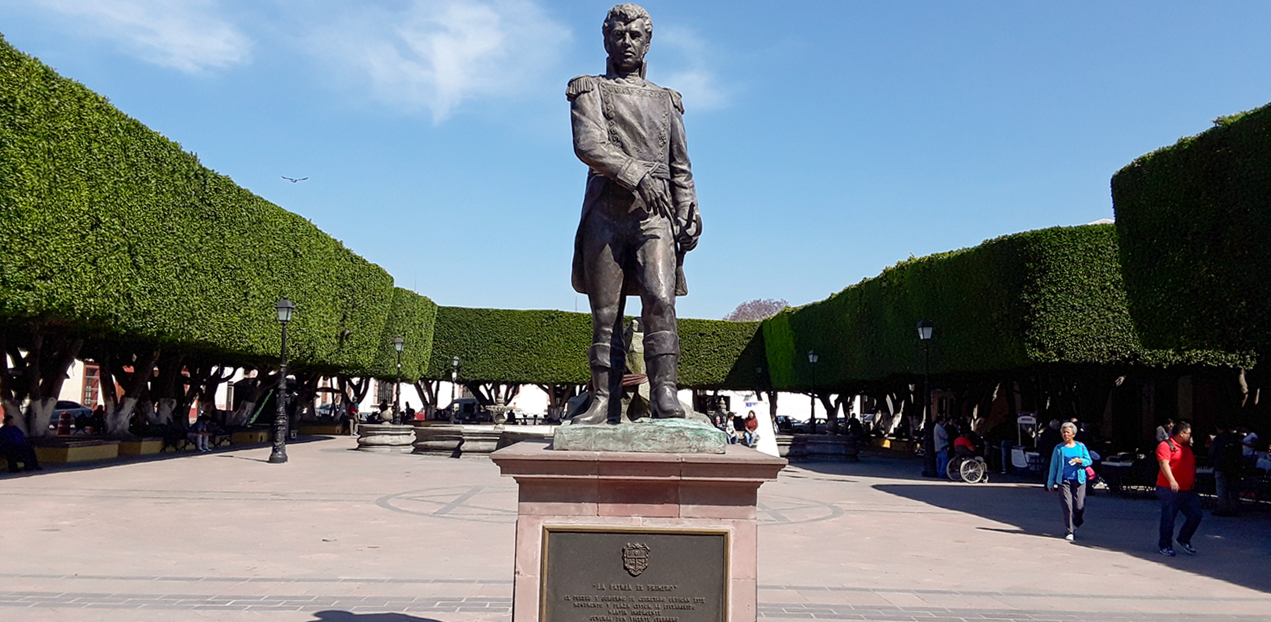


The Colonial Mexico experience
In May 1521, Cortés and his followers attacked and conquered the Aztecs. Corté then colonized the area and named it Nueva España (New Spain). By 1574, Spain controlled a large portion of the Aztec empire and had enslaved most of the indigenous population.
On August 24, 1821, O'Donojú signed the Treaty of Córdoba, thus ending New Spain’s dependence on Old Spain.
Although the life was very complexed during those 300 colonial years, today there are several cities in Mexico with well-preserved Spanish colonial architecture. Santiago de Queretaro is one of them.
About Santiago de Querétaro
Santiago de Querétaro is a city in central Mexico an on of a group of old Silver Mining cities and has its own unique character, features and atmosphere. It’s known for its well-preserved Spanish colonial architecture such as a striking pink stone aqueduct. Notable baroque buildings include Santa Rosa de Viterbo church. The nearby ochre San Francisco church is in Zenea Garden, the city’s main square. In the old church convent, the Quertaro Regional Museum displays pre-Hispanic, colonial and republican artifacts. Queretaro enjoys year-round hot, dry weather. The climate is ideal for taking part in a variety of outdoor sports and activities and for taking in the local culture, architecture and scenery. Santiago de Queretaro, or just Queretaro as its known, is a colonial city steeped in Mexican history. The Spanish took control of the city in 1531 and designated it the “third city of New Spain”. It was here where the father’s of Mexico’s Independence Movement met in secret to discuss the overthrow of their Spanish rulers. The Mexican Constitution, written in 1917, was composed here— the same document that underscores the rule of law in Mexico today. Queretaro was also the birthplace of the Partido Revolucionario Institucional (PRI) - the political party that governed Mexico for 71 years, before Vicente Fox’s PAN (Partido de Accion Nacional) ousted the regime in July of 2000.
This colonial city is one for walkers. Walk around the streets and discover little plazas leading off narrow alleys. At night, Queretaro lights up with a carefully orchestrated system of flood lighting, giving the whole place a wonderful look, feel and atmosphere. The most importantly, the city is safe with a very low crime rate.
People are saying that it is in the colonial cities that the real Mexico begins to emerge. There you can find real people living real lives; for some of them it's a good life but for many of others it's not. However, they all are happy with what they have. Walking throughout streets of Querétaro was just like a dream going into the past times, feeling Baroque everywhere around you. it seems to be a different world.
La Patria es primero

The colonies were a fundamental pillar for the development of European countries, by providing them with goods and a workforce, which helped countries to get richer and more powerful over European kingdoms. Historians have shown that many of the goods that Europeans craved such as gold, silver, and precious woods, foods like tomatoes, chocolate, corn, potatoes, and other products that Europeans did not have, were the fruits of enslaving people from places they had conquered. Slavery had existed well before the discovery of the “New World” however, the commerce of Africans became important for Europe only after the 15th century when they began to settle there and build colonies. The first Africans in New Spain accompanied explorers and conquistadors like Christopher Columbus and Hernan Cortes. Later enslaved Africans were taken to work in cotton fields or sugar plantations, cultivating coffee, tobacco, and rice, mining minerals, and other painful physical work. Gradually, blacks started to take roles previously performed by Mexican natives, whose population steadily declined from years of abuse from conquistadors, as well as the introduction of European diseases, such as smallpox, measles, influenza, pneumonia, typhus, cholera, and bubonic plague, brought by the Spaniards. Vicente Guerrero’s journey as a national hero began while traveling as an “arriero” around New Spain and becoming familiar with the growing independence movement and meeting Jose Maria Morelos y Pavon, a leader of the rebellious movement. Guerrero started his military career in 1810 after meeting Morelos and participated in many important engagements, such as battles at Izucar and Taxco, first, under the command of insurgent leader Hermenegildo Galeana, then under Morelos. After Morelos was executed by a Spanish firing squad in 1815, Guerrero became the new Commander in Chief of the insurgent army. Guerrero became more powerful with every victory and in an effort to stop him, the Spaniards, in 1819, convinced his father to beg his son to offer his sword in surrender to the viceroy of New Spain. Instead, the younger Guerrero said defiantly, “Brothers, this old man is my father. He has come to offer me rewards in the name of the Spaniards. I have always respected my father, but my Motherland comes first.”
Queretaro itself is a bright, lively and very clean city. It’ just 130 miles north-west of Mexico City and is connected by high-speed modern highways.
The local government in Queretaro strives to make the colonial city a pleasant place for people to live in and visit; and you will find that the historic colonial center is pristinely well kept and maintained.

There are many more memories in our album about this city, but we will close out the Queretaro page with a few more.
The next Colonial Mexico experience will take us to the beautiful city of San Miguel de Allende. We’ll see you there.